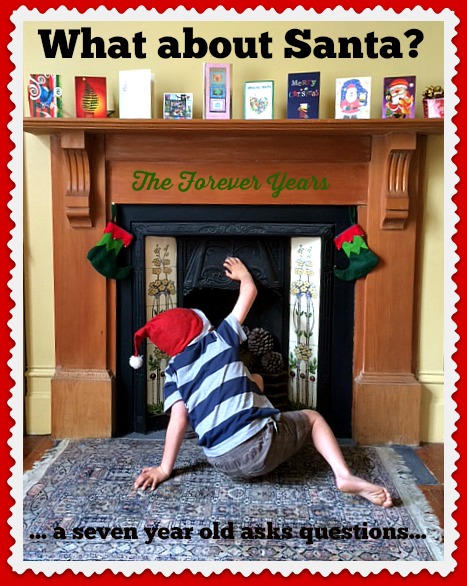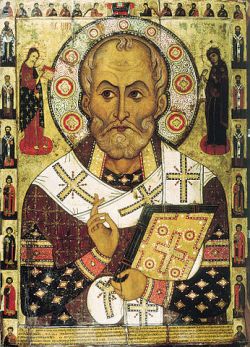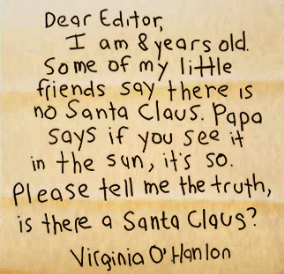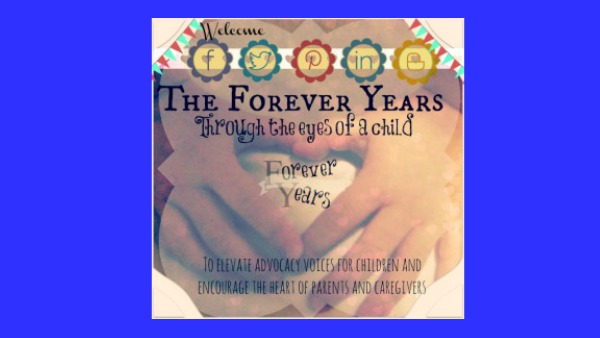 By Kirsteen McLay-Knopp
By Kirsteen McLay-Knopp
“What about Santa?” my seven year old son asks me.
“What do you mean?” I reply.
“I mean, what about Santa? There are all these poor kids in the world with no toys and Santa’s supposed to give presents to everyone. Why doesn’t Santa just come along and give them all stuff? They haven’t all been naughty have they?”
He’s a serious wee guy, this second son of mine, with a really good heart for helping those less fortunate than himself. What to say? I reassure him that no, the children in poorer parts of the world (and those whose families are struggling here in our own country) haven’t all been naughty. At the same time, I think to myself that not every child who receives an expensive present has been consistently “good”. I manage to mumble some stuff about Santa being very busy and having so many countries to visit in one night and sometimes Santa needs help in looking after the “poor people”, so those of us who are more fortunate can help (like with the “Operation Christmas Child” shoe boxes… see older posts on this blog). I can tell that my son is not entirely satisfied with my answer.
 Why do we have Santa Claus in our culture? What’s the history and meaning behind the old man in red? He’s nothing to do with the birth of Jesus (just by the way, many “Christmas” things including decorated trees have nothing to do with the birth of Christ either). When I was teaching English in Vietnam some years ago and explaining Christmas traditions, one of my students said, after having heard about Santa Claus, “so you lie to your children? And you tell them that someone comes into your homes in the middle of the night while you are asleep?”. Put like that, it does sound like a weird custom.
Why do we have Santa Claus in our culture? What’s the history and meaning behind the old man in red? He’s nothing to do with the birth of Jesus (just by the way, many “Christmas” things including decorated trees have nothing to do with the birth of Christ either). When I was teaching English in Vietnam some years ago and explaining Christmas traditions, one of my students said, after having heard about Santa Claus, “so you lie to your children? And you tell them that someone comes into your homes in the middle of the night while you are asleep?”. Put like that, it does sound like a weird custom.
Santa Claus… Kris Kringle…Old Saint Nick… We see him on advertising posters, in parades, at departments stores… who is this guy and why does he have so many aliases? And how does he accomplish the seemingly impossible task of flying around the world and delivering (house by house) presents for every single child on the planet (but, as my seven year old noted, forgetting the poor and disadvantaged who don’t seem to get anything)?

St. Nicholas “Lipensky” (1294), Lipnya Church of St. Nicholas in Novgorod
The original St. Nicholas lived in southwestern Turkey in the 4th century. As the bishop of Myra he was credited with doing a number of miracles involving sailors and children. After his death this led him to become the patron saint of both groups as well as for unmarried girls. As a saint he was given his own “feast day” which was celebrated on December 6th.
At about the same time Nicholas lived, Pope Julius I decided to establish a date for the celebration of the birth of Jesus. As the actual time of year for this event was unknown, the Pope decided to assign the holiday to December 25th. There had long been a pagan midwinter festival at this time of year and the Pope hoped to use the holiday to Christianize the celebrations.
Eventually, Saint Nicholas’s feast day also became associated with December 25th and his connection with Christmas was established. A tradition developed that he would supposedly visit homes on Christmas Eve and children would place nuts, apples, sweets and other items around the house to welcome him.
From these origins, the Santa Claus we know today evolved. In the now famous poem The Night Before Christmas (written by Clement Moore in 1822), Saint Nicholas is depicted with a sleigh drawn by eight (named) reindeer. They fly him from house to house and at each residence he comes down the chimney to fill stockings hung by the fireplace with gifts. Where did Moore get the idea of Santa Claus having reindeer? The Saami people of northern Scandinavia and Finland often used reindeer to pull their sledges around and this found its way into the poem.

1881 illustration by Thomas Nast

Norman Rockwell’s 1921 cover for the magazine The Country Gentleman shows Santa with his modern red and white theme.
|
As time went by, more and more was added to the Santa Claus legend. Thomas Nast, a 19th century cartoonist, did a series of drawings for Harper’s Weekly. Nash’s vision of Santa had him living at the North Pole. Nash also gave him a workshop for building toys and a large book filled with the names of children who had been naughty or nice.
The 19th century Santa was often shown wearing outfits of different colors: purple, green and blue in addition to red. This slowly faded out so that by the beginning of the 20th century the standard image of Santa Claus was a man in a red suit trimmed with white.
So the question remains: should we tell our children about Santa Claus? I know people who, for various reasons (including that Santa detracts from celebrating the birth of Jesus and that the whole “Santa story” is just an excuse for excessive Western materialism) do not want the old dude in the red suit associated with their Christmas at all. I can understand these sentiments at one level and everyone is entitled to make their own choices. Just as I know Christian people who do and who do not incorporate Santa Claus into their celebrations, I also know a number of people of other faiths whose views about him differ. Muslim friends of ours take their children to Santa every year because “…the kids love it and he doesn’t have anything to do with religion.” Many feel that he’s a kind of “uniting figure” of childhood, a “shared memory” of children around the globe, creating the “Forever Years” of their Christmases.
I don’t recall ever feeling “lied to” as a child about the existence of Santa Claus. What I do recall, if I really think back to the Christmases of my childhood, is the intense excitement I felt on Christmas Eve, even if it was tempered, once I passed a certain age, with some suspicions. I still feel that excitement now as I see my own children when the “special day” draws nearer and when I find my seven year old attempting to put his head up our chimney (I did this too as a child and ended up covered in soot).
A sense of this joy and childhood Christmas wonder is conveyed in the famous answer to an American girl’s letter to the editor of The New York Sun newspaper, in 1897, in which she asks whether there really is a Santa Claus. I will print this below, you might enjoy reading it with your children this Christmas. May we all share joy and the spirit of kindness and giving not just with our families, but also with all “our” children, the children of the world, at Christmas time and all through the year.

Left: Virginia O’Hanlon Right: Francis Church, writer for “The Sun”
 Newsman Francis Church wrote The Sun’s reply to Virginia’s letter:
Newsman Francis Church wrote The Sun’s reply to Virginia’s letter:
Virginia, your little friends are wrong. They have been affected by the skepticism of a skeptical age. They do not believe except they see. They think that nothing can be which is not comprehensible by their little minds. All minds, Virginia, whether they be men’s or children’s, are little. In this great universe of ours, man is a mere insect, an ant, in his intellect as compared with the boundless world about him, as measured by the intelligence capable of grasping the whole of truth and knowledge.
Yes, Virginia, there is a Santa Claus. He exists as certainly as love and generosity and devotion exist, and you know that they abound and give to your life its highest beauty and joy. Alas! how dreary would be the world if there were no Santa Claus! It would be as dreary as if there were no Virginias. There would be no childlike faith then, no poetry, no romance to make tolerable this existence.
We should have no enjoyment, except in sense and sight. The external light with which childhood fills the world would be extinguished.
Not believe in Santa Claus! You might as well not believe in fairies. You might get your papa to hire men to watch in all the chimneys on Christmas Eve to catch Santa Claus, but even if you did not see Santa Claus coming down, what would that prove? Nobody sees Santa Claus, but that is no sign that there is no Santa Claus. The most real things in the world are those that neither children nor men can see. Did you ever see fairies dancing on the lawn? Of course not, but that’s no proof that they are not there. Nobody can conceive or imagine all the wonders there are unseen and unseeable in the world.
You tear apart the baby’s rattle and see what makes the noise inside, but there is a veil covering the unseen world which not the strongest man, nor even the united strength of all the strongest men that ever lived could tear apart. Only faith, poetry, love, romance, can push aside that curtain and view and picture the supernal beauty and glory beyond. Is it all real? Ah, Virginia, in all this world there is nothing else real and abiding.
No Santa Claus! Thank God! He lives and lives forever. A thousand years from now, Virginia, nay 10 times 10,000 years from now, he will continue to make glad the heart of childhood.
—————–
“Is There a Santa Claus?” reprinted from the September 21, 1897, number of The New York Sun.

Related Links:
http://www.unmuseum.org/santa.htm
http://www.nysun.com/editorials/yes-virginia/68502/







































